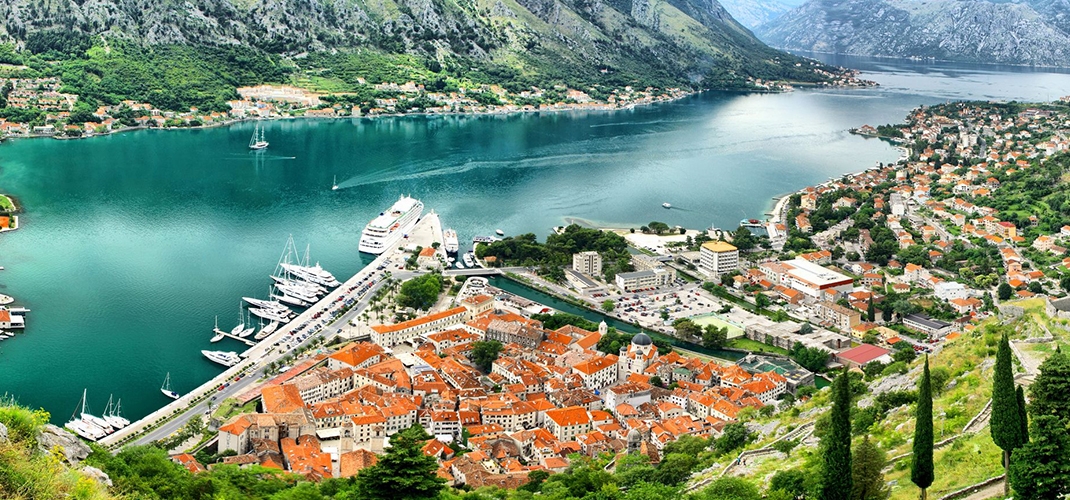Montenegro

This small but impressive country of Montenegro is fast becoming one of Europe's tourism meccas with quaint historic towns, stunning beaches that lie against a backdrop of crystal clear water from the Adriatic Sea and the extraordinary Venetian Old Town of Kotor, backed by a spectacular deep blue, fjord like bay, to the mountainous interior, filled with National Parks, towering peaks and underground caverns.
Kotor's Old Town is one of the Adriatic Coast's finest preserved fortified medieval towns with the 12 Century Cathedral of Saint Tryphon, known for its beautiful stone carved alter. With a noticeably Venetian style, Kotor lies beside the Bay of Kotor, which is surrounded by towering mountains. Wander the many streets throughout the Old Town while enjoying lunch or dinner in one of its many cafés or restaurants. For the fit, climb up the Upper Town walls for spectacular views over both the City and the Bay.
The Budva Riviera sits along the Montenegrin coastline and is a favourite summer beach destination amongst both locals and tourists. The beaches are a mix of sand and pebbles, backed by clear, turquoise and aquamarine blue hues of the Adriatic Sea on one side and dramatic mountains on the other. Some of the best beaches include Mogren Beach, which is the closest to Budva’s Old Town. The history of this medieval walled city dates back 2,500 years and has a dynamic atmosphere with its streets lined with restaurants and shops. Situated along the Budva Riviera, Sveti Stefan is connected to the mainland by a narrow isthmus. The town became popular in the 1950’s when it was transformed into a luxury resort with guests like Sophia Loren and Marilyn Monroe who would vacation here. Although the beaches are public, the original village is only open to visitors who stay at the Aman Resort.
Sitting just to the northwest of the Bay of Kotor is Perast, a picturesque town famous for its multiple Churches and stone crafted villas. You will have spectacular views from the Belfry Tower of the Church of St. Nikola over the town and the Bay of Kotor. A couple of the most stunning Churches include Our Lady of the Rocks and St. George, which are both situated on tiny islets in the Bay.
The 15th Century town of Cetinje was the Old Capital of Montenegro during the late 19th-20th Centuries. At the time, the inland valley locale sat at the boundary of what was then the Ottoman Empire, making it a coveted spot to conduct diplomacy. The Embassies have today been turned into Museums, Government buildings and Educational Academies. The Cetinje Monastery has a collection of Early Christian era relics you can see for a donation and the 15th Century Vlah Church is also worth a visit.
Inspired by its towering granite peaks, Mount Lovćen is a source of national pride and close to Cetinje. Protected as a part of the Mount Lovcen National Park, the views from the circular platform at the top are genuinely stunning and have you looking down upon the Bay of Kotor and the medieval city of Kotor.
The Lipa Cave is one of the largest caves in Montenegro, just a few kilometres from Cetinje. The cave was accidently discovered by a dog who fell through a hole however, managed to escape safely through another opening. The Karst cavern is now a major tourist attraction and your visit will begin with a miniature train ride through the countryside, full of pomegranates and wild fig trees to the cave's entrance. Join a guided tour for the best experience through some of the 3.5 kms of passages and great halls carved by thousands of years of dripping water and its underground river.
Montenegro still has some relatively undiscovered areas including the Lustica Peninsula, which is home to charming villages, beautiful beaches and the Blue Grotto. The Grotto is named for its florescent blue water, which gets its dramatic hues from the light reflecting off the sandy bottom in the round shaped cave with a vaulted ceiling. The best way to access the Blue Grotto is by boat and tours depart regularly from Herceg Novia Marina between April-October. The cave is also a great spot for snorkelling and diving.
The 17th Century Ostrog Monastery was a refuge against the Ottoman Empire invaders, however now it has become a major Christian pilgrimage destination. Sitting atop a large granite ledge, the entire Monastery was carved from a cave on a nearly vertical cliff. This exquisite site has two inner Cave Churches and is adorned with frescos painted onto the rock walls. The Monastery also houses the remains of its founder, Sveti Vasilje, who later became a Saint after his death in 1671.
Lake Skadar borders with Albania and is the largest natural lake in all of Southern Europe. This natural destination hosts multiple species of migratory birds and wildlife with the Montenegrin side of the lake designated as a National Park. The best way to explore the lake is by taking a boat excursion, checking out the 13th Century villages that line it, which are designated UNESCO World Heritage Sites.
Located near the southern point of Montenegro is Ulcinj, an ancient seaport that was once infamous as the Adriatic Sea's pirate capital. However nowadays Ulcinj is a unique Montenegrin town, with beautiful Mosques and excellent Middle Eastern restaurants and coffee shops along its seaside promenade. The local area is known for its beaches including Velika Plaza, which is Montenegro’s longest beach at 12 kms in length. It is a great location for kite surfers and families as the water is shallow.
Montenegro has so much to offer and if your time allows here are some other places to visit on your trip. The stunning Biogradska Gora National Park is located between the Lim and Tara Rivers. The main highlight is Lake Biograd, a large glacial lake in the middle of the park. Black Lake in Durmitor National Park is located in the Dinaric Alps and is home to some 18 glacial lakes, the Tara River and the world's second deepest canyon. It is also home to thick forests and wildlife, with brown bears to wild boars and 163 different species of birds. Tara Canyon is another amazing natural wonder and after the Grand Canyon, it is the world's deepest canyon and just like the Grand Canyon, it can be experienced on a white water rafting trip. If you don't want to get wet, you can see the canyon from the 172 metre Ðurdevica Tara Bridge or for those adrenalin junkies you can zipline across the canyon.
Filter Results
Trip Duration
Price Range
Country Destinations
Select Countries to Visit
City Destinations
Select Cities to Visit
Tour Categories
Select a Tour Category
Filter Results
Trip Duration
Price Range
Country Destinations
Select Countries to Visit
City Destinations
Select Cities to Visit
Tour Categories
Select a Tour Category
